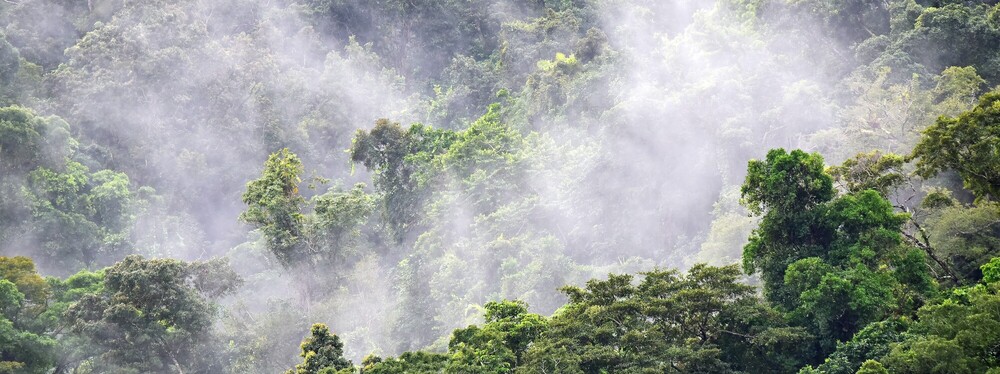
Singapore's climate
Singapore is located between the 1st and 2nd parallel and it is characterized by a tropical climate. It has abundant rainfall throughout the year, high temperatures and high relative humidity. The outdoor temperature do not vary much between seasons. All months have mean daily max temperature in the low thirties and mean daily minimum temperatures in the mid twenties. The highest temperature excursions are observed intra-day, at night outdoor temperatures are significantly lower than during the day.
Rainfall
In Singapore rains approximately every second day on average (167 days of rain). Rain is often heavy and afternoon thunderstorms are frequent. The NEA reports that the long term total mean annual rainfall is 2166 mm.
While in Singapore often rains and there is not an official dry season, it generally rains more between November and January, as it can been seen in the Figure below. This is caused by the fact that the tropical rain-belt moves towards Singapore. The bar chart shows the monthly cumulative rainfall and the number of rain days at Changi weather station between 1982 and 2020. The driest month on average is February since the same rain-belt moves south towards Java. Rainfall frequently occurs in the afternoon, consequently most of the rin falls during the day and not at night. In addition, despite the fact that Singapore is a small country (approximately 50 km in width), most of the rain falls on the western side of the island.
This bar chart shows the monthly cumulative rainfall (blue) and the number of rain days (green) at Changi weather station between 1982 and 2020.
Temperature
High temperatures are recorded in Singapore throughout the year. The outdoor temperature rarely falls below 23 - 25 °C at night and does not exceed 31 - 33 °C during the hottest hours of the day. May and June are characterized by the highest mean monthly temperatures (daily mean temperature 27.8 °C), while December and January are the coolest months (daily mean temperature 26.0 °C). The tropical heat is mitigated by the sea, which surrounds the whole country and dampens temperature fluctuations between day and night and between seasons. Bukit Timah is the highest point (163 meters) in Singapore the temperature on this hill is not much lower than the other surrounding areas. The figure below shows the temperature variation across different months of the year in Singapore from collected between 2016 and 2020 across all weather stations in Singapore.
This line chart shows the monthly maximum, mean daily maximum, mean (average), mean daily minimum, and minimum temperatures recorded outdoors in all Singapore between 2016 and 2020.

The heatmap shows how the temperature outdoors in Singapore varies by time of day and month. The figure was generated using data from all Singaporean weather stations collected between 2016 and 2020.
Relative Humidity
Singapore is very humid throughout the year. The biggest fluctuations in relative humidity are observed between dawn and mid-day due to the marked change in temperature between these two periods. With relative higher than 90 % before sunrise and around 60 % in the early afternoon, when it does not rain. Despite the hot temperatures recorded in Singapore, relative humidity frequently reaches 100 %.
Seasons
Singapore climate is characterized by two distinct monsoon seasons separated by two inter-monsoonal periods. One monsoon season (Northeast Monsoon) periodically occurs between December and early March, while the second monsoon season is from June to September (Southwest Monsoon).
Northeast Monsoon (Dec - Mar)
Is generally characterized by northerly to northeasterly winds and it has two distinct phases. The wet phase (December to early January) features moderate to heavy rains with wind gusts that can reach up to 25-35 km/h, and rapid development of afternoon showers. Which are caused the sun radiation heating up the ground which in turns heats up the air. Hot air rises to produce convective clouds which can turn into intense thunderstorms if the monsoon-rain belt is in the vicinity of Singapore.
Inter-monsoon (Mar - May)
This phase is characterized by light and variable winds. Daily maximum temperatures which can exceed 32 °C and afternoon and late night thunderstorms.
Southwest Monsoon (Jun - Sep)
During this monsoon season Sumatra Squalls occasionally occurs between dawn and noon. With wnd gusts that can reach up to 40-80 km/h. Afternoon showers are also common. Southeasterly to southerly winds are frequent in this period.
Inter-monsoon (Oct - Nov)
This phase is characterized by light and variable winds. Afternoon thunderstorms are frequent. Higher rainfalls are registered in this during these months than in the previous inter-monsoon period.